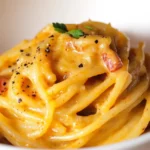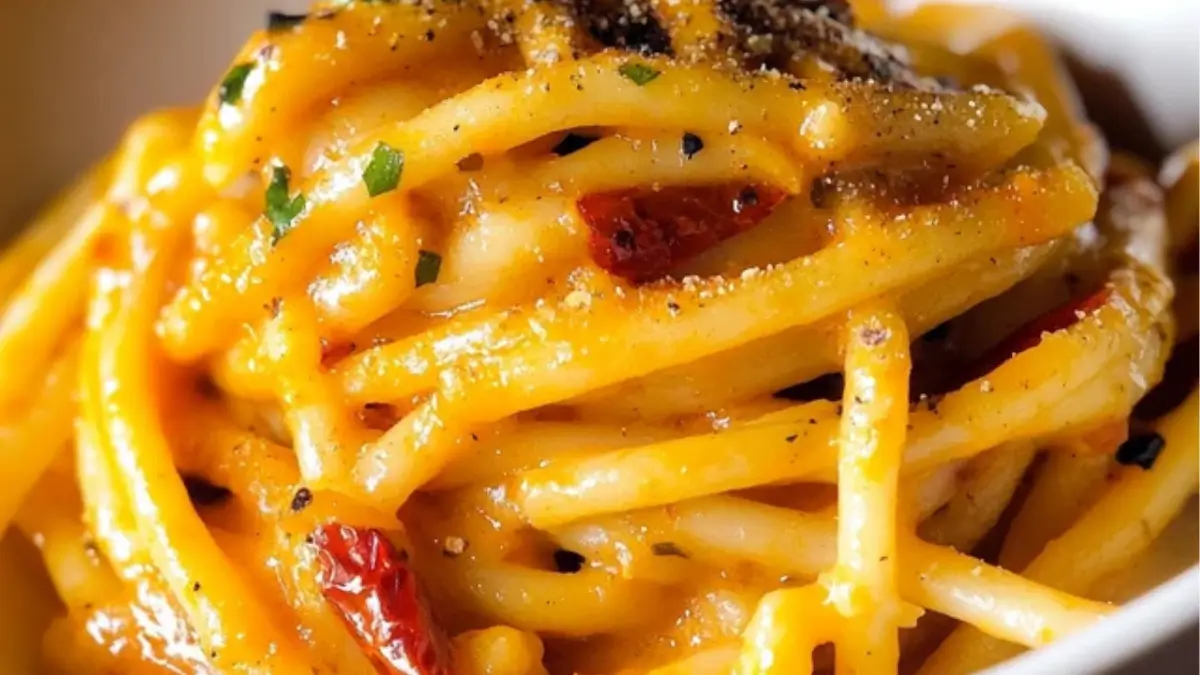There’s something about pasta after a long day that just hits differently. I remember walking into my kitchen after an exhausting shift, craving comfort without effort. That’s when I stumbled upon my now go-to: a Garlic Chilli Cacio e Pepe. It’s a bold, warming dish that feels fancy, yet requires only a few pantry staples.
If you’re new to cooking and looking for a dish that feels gourmet without the fuss, this is it. This easy sheet pan dinner (well, pan-only!) combines the richness of butter, the sharpness of Pecorino cheese, the aroma of garlic, and a fiery kick from chilli—making it a satisfying, quick and healthy meal for any weeknight.

Why This Recipe is Special
At its core, Cacio e Pepe is Italy’s answer to minimalist cooking. Traditionally, it uses just three ingredients: pasta, Pecorino Romano, and black pepper. This spicy spin honors the original while elevating it with garlic, fresh chillies, and a touch of Kashmiri chilli powder. The result is a dish that’s rich, vibrant, and utterly addicting.
What makes this recipe perfect for beginners?
- Minimal Ingredients – Pantry-friendly, no exotic runs to specialty stores.
- Quick to Cook – Ready in about 30 minutes, start to finish.
- Beginner Technique – A chance to learn emulsification (fancy word for mixing water + fat into a silky sauce).
- Customizable Heat – Mild or fiery, it’s your call.
Let’s break it down together.
Ingredients and Preparation
Here’s what you’ll need to gather:
Spaghetti or Bucatini – The backbone of the dish. Dried pasta is ideal here because it releases starch into the boiling water, which helps build that creamy sauce later.
Garlic – Adds an aromatic base and sweetness when sautéed gently. Fresh cloves are a must—skip the jarred stuff for best results.
Bird’s Eye Chillies – These small chillies add serious heat and a vibrant zing. Fresh chillies create more depth than dried flakes, but you can sub with jalapeños for milder heat.
Kashmiri Chilli Powder – Used more for its color and gentle warmth than spiciness. Paprika or mild chilli powder can work in a pinch.
Shallot – Brings mild sweetness to balance the bold garlic and chilli notes.
Butter – Adds richness and body to the sauce. No margarine here—real butter makes all the difference.
Pecorino Romano – The star cheese. It’s nutty, salty, and melts beautifully when finely grated. Parmesan works too, but Pecorino delivers that authentic Roman punch.
Whole Black Peppercorns – Freshly toasted and crushed, they bring warmth and complexity. Pre-ground pepper simply won’t cut it.
Fresh Parsley – For freshness and color at the end. Optional, but recommended.
Ingredient Substitutions:
- Can’t find Pecorino? Use Parmigiano Reggiano.
- Too spicy? Use half the chillies or remove the seeds.
- No shallot? Swap with a small yellow onion.
Step-by-Step Instructions
Step 1 Start by boiling your dried pasta in salted water. Cook it for one minute less than the package recommends—it will finish in the sauce later. While the pasta boils, reserve at least one cup of that starchy water.
Step 2 Toast the whole black peppercorns in a dry pan over low heat until fragrant. This brings out their floral and smoky notes.
Step 3 Grind the toasted peppercorns using a mortar and pestle or spice grinder until coarsely crushed. You want texture, not dust.
Step 4 In a wide pan, melt butter over low heat. Add the crushed pepper and toast briefly to infuse the butter.
Step 5 Toss in the shallots, cooking gently until translucent. Then add minced garlic and finely sliced chillies. Sauté until the garlic just starts to turn golden.
Step 6 Add the Kashmiri chilli powder and stir to blend. It should sizzle slightly and color the butter beautifully.
Step 7 With the heat off, add a ladle of the reserved pasta water to the pan. Swirl to loosen the bits stuck to the bottom.
Step 8 Add your undercooked pasta into the pan and begin stirring. Then sprinkle in the finely grated Pecorino a little at a time, mixing vigorously.
Step 9 This part is crucial: mix until the cheese and starchy water emulsify into a smooth, creamy sauce. Add more pasta water if it seems too thick or clumpy.
Step 10 Finish with chopped parsley and serve hot. You’ve officially made Garlic Chilli Cacio e Pepe!
Beginner Tips and Notes
- Cheese Won’t Melt? The pan was probably too hot. Always turn off the heat before adding cheese to avoid splitting.
- Sauce Too Thin? Stir in more grated cheese. Still too thick? Add more pasta water a splash at a time.
- Pasta Breaking? It’s overcooked. Always cook pasta just shy of al dente if finishing in sauce.
- No Mortar and Pestle? Use the bottom of a heavy skillet to crush your peppercorns in a zip-top bag.
Pro Tool Tip: A microplane or fine grater is essential for grating cheese into a fluffy, meltable texture. Pre-shredded cheese won’t work here—it has anti-caking agents that prevent proper melting.
Serving Suggestions
This pasta stands proudly on its own but pairs beautifully with:
- A simple arugula salad with lemon and olive oil to cut through the richness.
- Garlic bread (because more garlic is never a bad idea).
- Roasted veggies like asparagus or zucchini for a full meal.
Storage Tips:
- This dish is best eaten fresh, but leftovers can be refrigerated for up to 2 days.
- Reheat gently with a splash of water in a non-stick pan to revive the sauce.
Final Thoughts
If you’re looking for an easy sheet pan dinner alternative or exploring new quick and healthy meals, this lemon herb chicken recipe-adjacent pasta might just become your new obsession. It’s a brilliant entry point into Italian cooking, offering bold flavor without complex steps.
So go ahead—light that stove, toast those peppercorns, and dive into your first taste of homemade Garlic Chilli Cacio e Pepe. If you try it, I’d love to hear about it in the comments. What did you tweak? Too spicy? Just right? Let’s talk pasta!
FAQ About Garlic Chilli Cacio e Pepe
It has a moderate to bold heat, thanks to bird’s eye chillies and Kashmiri chilli powder. You can adjust the spice by using fewer chillies or a milder variety.
This usually happens if the pan is too hot. Turn off the heat before adding cheese and mix vigorously with the starchy pasta water to form a smooth sauce.
Dried pasta is essential for this recipe because it releases more starch into the water, helping to create that creamy emulsified sauce. Fresh pasta isn’t ideal here.
Yes, as long as you choose vegetarian Pecorino or Parmesan. Many store brands like Waitrose or Tesco offer vegetarian options.
More Relevant Recipes
Print
Garlic Chilli Cacio e Pepe
- Total Time: 30 minutes
- Yield: Serves 3
Description
A bold and creamy twist on the classic Roman pasta, Garlic Chilli Cacio e Pepe features fiery chillies, toasted black pepper, and rich Pecorino cheese in a silky, comforting sauce that’s perfect for quick weeknight meals.
Ingredients
- 250 g dried spaghetti or bucatini
- 1 tsp whole black peppercorns
- 1 shallot, diced
- 4 cloves garlic, minced
- 2 red bird’s eye chillies, finely sliced
- 2 tsp Kashmiri chilli powder
- 50 g salted butter
- 70 g Pecorino Romano, very finely grated (plus extra for garnish)
- A handful of fresh parsley, roughly chopped
- Salt (for pasta water)
Instructions
- Boil the Pasta: Bring a large pot of salted water to a boil. Cook the spaghetti one minute less than the package suggests. Save a cup of pasta water before draining.
- Toast the Pepper: In a wide, dry pan over low heat, toast the whole black peppercorns until fragrant. Transfer to a mortar and pestle and grind into a coarse texture.
- Sauté the Aromatics: Melt butter in the same pan over low heat. Add the freshly ground black pepper, then stir in the diced shallot, garlic, and bird’s eye chillies. Cook gently until the garlic turns lightly golden and shallots are translucent.
- Infuse the Spice: Lower the heat and sprinkle in the Kashmiri chilli powder. Let it toast and blend with the butter, creating a deep red, aromatic base.
- Create the Sauce Base: Turn off the heat completely. Add a ladle of the reserved starchy pasta water and swirl to deglaze the pan.
- Finish the Pasta: Add the undercooked spaghetti to the pan. Sprinkle in the finely grated Pecorino and stir vigorously to emulsify the cheese, pasta water, and butter into a creamy, smooth sauce.
- Serve and Garnish: Add the chopped parsley and a final sprinkle of cheese, then serve immediately while hot and glossy.
Notes
- Use only freshly grated cheese—pre-shredded varieties contain starch that prevents melting. Don’t skip the pasta water; it’s crucial for creating the silky sauce. If your sauce seems too thick, add a splash more water. If it’s too thin, stir in a bit more cheese. De-seed the chillies or swap for a milder type if you prefer a gentler heat.
- Prep Time: 10 minutes
- Cook Time: 20 minutes
- Category: Dinner, Pasta
- Method: Stovetop
- Cuisine: Italian
Nutrition
- Serving Size: 1 plate
- Calories: 590 kcal
- Sugar: 3 g
- Sodium: 480 mg
- Fat: 29 g
- Saturated Fat: 17 g
- Unsaturated Fat: 10 g
- Trans Fat: 0.5 g
- Carbohydrates: 62 g
- Fiber: 4 g
- Protein: 19 g
- Cholesterol: 65 mg

